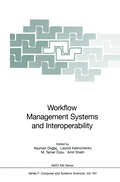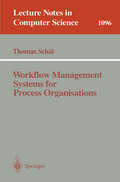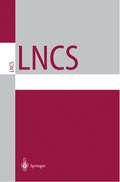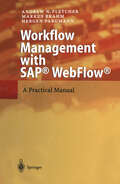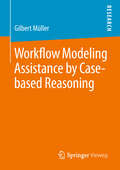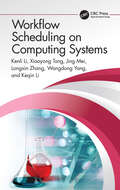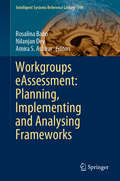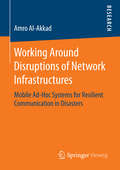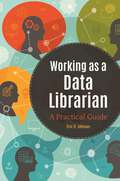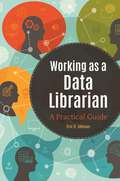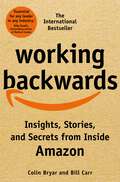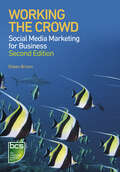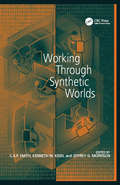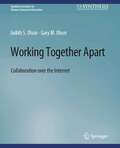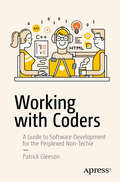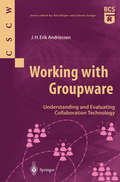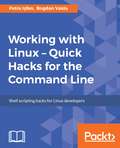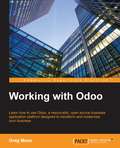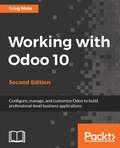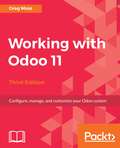- Table View
- List View
Workflow Management Systems and Interoperability (NATO ASI Subseries F: #164)
by Asuman Dogac Leonid Kalinichenko Tamer Özsu Amit ShethWorkflow management systems (WFMS) are enjoying increasing popular ity due to their ability to coordinate and streamline complex organizational processes within organizations of all sizes. Organizational processes are de scriptions of an organization's activities engineered to fulfill its mission such as completing a business contract or satisfying a specific customer request. Gaining control of these processes allows an organization to reengineer and improve each process or adapt them to changing requirements. The goal of WFMSs is to manage these organizational processes and coordinate their execution. was demonstrated in the first half The high degree of interest in WFMSs of the 1990s by a significant increase in the number of commercial products (once estimated to about 250) and the estimated market size (in combined $2 billion in 1996. Ensuing maturity product sales and services) of about is demonstrated by consolidations during the last year. Ranging from mere e-mail based calendar tools and flow charting tools to very sophisticated inte grated development environments for distributed enterprise-wide applications and systems to support programming in the large, these products are finding an eager market and opening up important research and development op portunities. In spite of their early success in the market place, however, the current generation of systems can benefit from further research and develop ment, especially for increasingly complex and mission-critical applications.
Workflow Management Systems for Process Organisations (Lecture Notes in Computer Science #1096)
by Thomas SchaelAs the business environment has become more and more turbulent over the past decade, information technology has begun to run into the danger of becoming an impediment rather than a motor of progress. In order to deal with the need for rapid, continuous change, computer science is challenged to develop novel interrelated information and communication technologies, and to align them with the social needs of co-operating user groups, as well as the management requirements of formal organisations. Workflow systems are among the most advertised technologies addressing this trend, but they mean different things to different people. Computer scientists understand workflows as a way to extract control from application programs, thus making them more flexible. Bureaucratic organisations (and most commercial products) perceive them as supporting a linear or branching flow of documents from one workplace to another - the next try after the failure cf office automation. This book takes another perspective, that of the modem customer-driven and groupwork-oriented process organisation. Extending the language-action perspective from the CSCW field, its customer-oriented view of workflows enables novel kinds of business process analysis, and leads to interesting new combinations of information and co-operation technologies. Schal's empirical studies show some of the pitfalls resulting from a naive use of these technologies, and exemplify ways to get around these pitfalls.
Workflow Management Systems for Process Organisations (Lecture Notes in Computer Science #1096)
by Thomas SchaelAll of us have learned a lot during this exercise, and the enormous success of the first edition of this book shows the great international interest for the topic and the results. A French edition appeared last year and met with equal interest. Springer-Verlag has therefore decided to publish a second edition of this book, which is not just a reprint but brings the literature and results to the newest state. This is a rare occurrence in the history of the LNCS series. We congratulate Thomas Schael on this success, and we are sure that reader- scientists and practitioners - will likewise profit from it. Aachen and Milan Giorgio De Michelis, Klaus Henning, Matthias Jarke August 1998 Preface to the Second Edition This book is a bit of a mixture of scientific and management literature. It is based on my research activities in the CSCW community, and also reflects the last ten years of my professional experience in consulting. I have had the opportunity to live in different cultural settings, to work in many companies, and to meet people all over the world, which has helped me to reflect on what I was doing and to focus on the content of this book. This second edition reflects the fast moving field of Computer Supported Cooperative Work (CSCW) and the discussion on Business Process Re-engineering (BPR). It contains the latest developments in the scientific and managerial discussion of the issues developed in the first edition.
Workflow Management with SAP® WebFlow®: A Practical Manual
by Andrew N. Fletcher Markus Brahm Hergen PargmannIt is now possible to gain competitive advantages based on consolidated R/3 system implementations. One of the most important optimisation aspects is a more consistent process integration in order to bring about fast, secure and cost effective business processes. This approach inevitably leads to Workflow Management and for SAP users to SAP® WebFlow®. This book introduces the topic of Workflow Management, gives an overview of the technical possibilities of SAP® WebFlow® and allows the reader to assess SAP workflow project risks and costs/benefits based on real life examples. Check lists and technical hints not only aid the reader in evaluating potential projects but also in the management of real life workflow project engineering.
Workflow Modeling Assistance by Case-based Reasoning
by Gilbert MüllerGilbert Müller introduces the foundations of Business Process Management as well as Case-based Reasoning and presents a novel approach to assist the complex, time-consuming, and error-prone task of workflow modeling. By means of methods from artificial intelligence, in particular from the field of Case-based Reasoning, he shows how workflows can be automatically constructed according to a query specified by the user. Thus, the modeling process can be supported substantially, which addresses a highly relevant problem in many workflow domains.
Workflow Scheduling on Computing Systems
by Kenli Li Keqin Li Xiaoyong Tang Jing Mei Longxin Zhang Wangdong YangThis book will serve as a guide in understanding workflow scheduling techniques on computing systems such as Cluster, Supercomputers, Grid computing, Cloud computing, Edge computing, Fog computing, and the practical realization of such methods. It offers a whole new perspective and holistic approach in understanding computing systems’ workflow scheduling. Expressing and exposing approaches for various process-centric cloud-based applications give a full coverage of most systems’ energy consumption, reliability, resource utilization, cost, and application stochastic computation. By combining theory with application and connecting mathematical concepts and models with their resource management targets, this book will be equally accessible to readers with both Computer Science and Engineering backgrounds.It will be of great interest to students and professionals alike in the field of computing system design, management, and application. This book will also be beneficial to the general audience and technology enthusiasts who want to expand their knowledge on computer structure.
Workflow Scheduling on Computing Systems
by Kenli Li Keqin Li Xiaoyong Tang Jing Mei Longxin Zhang Wangdong YangThis book will serve as a guide in understanding workflow scheduling techniques on computing systems such as Cluster, Supercomputers, Grid computing, Cloud computing, Edge computing, Fog computing, and the practical realization of such methods. It offers a whole new perspective and holistic approach in understanding computing systems’ workflow scheduling. Expressing and exposing approaches for various process-centric cloud-based applications give a full coverage of most systems’ energy consumption, reliability, resource utilization, cost, and application stochastic computation. By combining theory with application and connecting mathematical concepts and models with their resource management targets, this book will be equally accessible to readers with both Computer Science and Engineering backgrounds.It will be of great interest to students and professionals alike in the field of computing system design, management, and application. This book will also be beneficial to the general audience and technology enthusiasts who want to expand their knowledge on computer structure.
Workflows for e-Science: Scientific Workflows for Grids
by Ian J. Taylor Ewa Deelman Dennis B. Gannon Matthew ShieldsThis is a timely book presenting an overview of the current state-of-the-art within established projects, presenting many different aspects of workflow from users to tool builders. It provides an overview of active research, from a number of different perspectives. It includes theoretical aspects of workflow and deals with workflow for e-Science as opposed to e-Commerce. The topics covered will be of interest to a wide range of practitioners.
Workgroups eAssessment: Planning, Implementing and Analysing Frameworks (Intelligent Systems Reference Library #199)
by Rosalina Babo Nilanjan Dey Amira S. AshourThis book was developed during a particular pandemic situation in the whole world which confined people to their homes. Therefore, there was a rise in the use of distance working and learning (e-learning) which led to a very quick adoption of technology in order to guarantee different approaches to fulfil the same or better outcomes and ensure that people are connected. This book provides a better understanding about the importance of teams' assessment and collaborative work, as well as the use of collaboration tools and online assessment techniques supported by technology. Consequently, the book is aimed at all institutions that seek new working environments, namely higher education institutions, companies and organizations, sports teams, and others. Furthermore, this book provides new approaches and systems to carry the knowledge and learning assessment. The book gathers knowledge from several authors, related to collaboration environments and tools, as well as their insights on how technology can be applied to carry assessment processes. The book seeks to provide knowledge on new technologies and different learning environments.
Working Around Disruptions of Network Infrastructures: Mobile Ad-Hoc Systems for Resilient Communication in Disasters
by Amro Al-AkkadAs in disasters the availability of information and communication technology services can be severely disrupted, the author explores challenges and opportunities to work around such disruptions. He therefore empirically analyzes how people in disasters use remnants of technology to still communicate their needs. Based on this, he suggests quality attributes whose implementation can support the resilience in technology. To exemplify this he develops iteratively two mobile ad-hoc systems and explores their feasibility and implications for emergency response under close-to-real conditions. Compared to the state of the art both systems are independent from preexisting network infrastructure and run on off-the-shelf smartphones.
Working as a Data Librarian: A Practical Guide
by Eric O. JohnsonMany librarians' job responsibilities increasingly require them to understand and handle data. Learn how to be an effective data librarian—even if you never expected to need data skills.The field of data librarianship is rapidly growing, and some librarians may feel that their training and experience does not cover data questions asked by patrons seeking advice. With this gentle guide for librarians moving—sometimes unexpectedly—into the world of data librarianship, all you need is a willingness to learn the skills required for the rapidly growing number of jobs requiring data librarianship.Working as a Data Librarian focuses on transferable skills and understanding and does not assume extensive knowledge. It introduces tasks and concepts needed to be an effective data librarian, such as best practices for data reference interviewing, finding data sources, data visualization, data literacy, the data lifecycle, metadata design, database design, understanding data management, and preparing data management plans. Additional sections focus on supporting creativity (Makerspaces and Fablabs, 3-D modeling), supporting analysis (GIS, data visualization, text mining, statistical methods), supporting research (digital scholarship, digital preservation, institutional data repositories, scholarly communication), and outreach (data librarian liaisonship, hackathons, developing outreach programs).
Working as a Data Librarian: A Practical Guide
by Eric O. JohnsonMany librarians' job responsibilities increasingly require them to understand and handle data. Learn how to be an effective data librarian—even if you never expected to need data skills.The field of data librarianship is rapidly growing, and some librarians may feel that their training and experience does not cover data questions asked by patrons seeking advice. With this gentle guide for librarians moving—sometimes unexpectedly—into the world of data librarianship, all you need is a willingness to learn the skills required for the rapidly growing number of jobs requiring data librarianship.Working as a Data Librarian focuses on transferable skills and understanding and does not assume extensive knowledge. It introduces tasks and concepts needed to be an effective data librarian, such as best practices for data reference interviewing, finding data sources, data visualization, data literacy, the data lifecycle, metadata design, database design, understanding data management, and preparing data management plans. Additional sections focus on supporting creativity (Makerspaces and Fablabs, 3-D modeling), supporting analysis (GIS, data visualization, text mining, statistical methods), supporting research (digital scholarship, digital preservation, institutional data repositories, scholarly communication), and outreach (data librarian liaisonship, hackathons, developing outreach programs).
Working Backwards: Insights, Stories, and Secrets from Inside Amazon
by Colin Bryar Bill Carr'Essential for any leader in any industry'Kim Scott, bestselling author of Radical CandorIn 2018 Amazon became the world’s second trillion dollar company after Apple: a remarkable success story for a company launched out of a garage in 1994. How did they achieve this? And how can others learn from this extraordinary success and replicate it?Colin started at Amazon in 1998; Bill joined in 1999. Their time at Amazon covered a period of unmatched innovation that brought products and services including Kindle, Amazon Prime, Amazon Echo and Alexa, and Amazon Web Services to life. Through the story of these innovations they reveal and codify the principles and practices that have driven the success of one of the most extraordinary companies the world has ever known, from the famous 14-leadership principles, the bar raiser hiring process, and Amazon’s founding characteristics: customer obsession, long-term thinking, eagerness to invent, and operational excellence.Through their wealth of experience they offer unprecedented access to the Amazon way as it was refined, articulated, and proven to be repeatable, scalable, and adaptable. Working Backwards shows how success is not achieved by the genius of any single leader, but rather through commitment to and execution of a set of well-defined, rigorously-executed principles and practices that you can apply at your own company, no matter the size.
Working On My Novel
by Cory ArcangelWhat does it feel like to try and create something new? How is it possible to find a space for the demands of writing a novel in a world of instant communication?Working on My Novel is about the act of creation and the gap between the different ways we express ourselves today. Exploring the extremes of making art, from satisfaction and even euphoria to those days or nights when nothing will come, it's the story of what it means to be a creative person, and why we keep on trying.
Working the Crowd: Social media marketing for business
by Eileen BrownEngaging with social media such as Facebook and Twitter is now a key part of global business communications. Blogs, social networking and social news sites have become the new tools for effective marketing and sales. This book is an excellent resource for anyone planning a social media strategy or campaign. It includes: sites and blogs for networking; social media brands and reputation; legal issues. This new edition covers the latest thinking, practices and technology such as Google+.
Working the Crowd: Social media marketing for business
by Eileen BrownEngaging with social media such as Facebook and Twitter is now a key part of global business communications. Blogs, social networking and social news sites have become the new tools for effective marketing and sales. This book is an excellent resource for anyone planning a social media strategy or campaign. It includes: sites and blogs for networking; social media brands and reputation; legal issues. This new edition covers the latest thinking, practices and technology such as Google+.
Working Through Synthetic Worlds
by Kenneth W. KisielVirtual environments (VE) are human-computer interfaces in which the computer creates a sensory-immersing environment that interactively responds to and is controlled by the behaviour of the user. Since these technologies will continue to become more reliable, more resolute and more affordable, it's important to consider the advantages that VEs may offer to support business processes. The term 'synthetic world' refers to a subset of VEs, having a large virtual landscape and a set of rules that govern the interactions among participants. Currently, the primary motivators for participation in these synthetic worlds appear to be fun and novelty. As the novelty wears off, synthetic worlds will need to demonstrate a favourable value proposition if they are to survive. In particular, non-game-oriented worlds will need to facilitate business processes to a degree that exceeds their substantial costs for development and maintenance. Working Through Synthetic Worlds explores a variety of different tasks that might benefit by being performed within a synthetic world. The editors use a distinctive format for the book, consisting of a set of chapters composed of three parts: ¢ a story or vignette that describes work conducted within a synthetic world based loosely on the question, 'what will work be like in the year 2025?', founded on the expert authors' expectations of plausible future technologies ¢ a scholarly review of the technologies described by the stories and the current theories related to those technologies ¢ a prescription for future research required to bridge the current state-of-the-art with the notional worlds described in the stories. The book will appeal to undergraduate and graduate students, professors, scientists and engineers, managers in high-tech industries and software developers.
Working Through Synthetic Worlds
by Kenneth W. KisielVirtual environments (VE) are human-computer interfaces in which the computer creates a sensory-immersing environment that interactively responds to and is controlled by the behaviour of the user. Since these technologies will continue to become more reliable, more resolute and more affordable, it's important to consider the advantages that VEs may offer to support business processes. The term 'synthetic world' refers to a subset of VEs, having a large virtual landscape and a set of rules that govern the interactions among participants. Currently, the primary motivators for participation in these synthetic worlds appear to be fun and novelty. As the novelty wears off, synthetic worlds will need to demonstrate a favourable value proposition if they are to survive. In particular, non-game-oriented worlds will need to facilitate business processes to a degree that exceeds their substantial costs for development and maintenance. Working Through Synthetic Worlds explores a variety of different tasks that might benefit by being performed within a synthetic world. The editors use a distinctive format for the book, consisting of a set of chapters composed of three parts: ¢ a story or vignette that describes work conducted within a synthetic world based loosely on the question, 'what will work be like in the year 2025?', founded on the expert authors' expectations of plausible future technologies ¢ a scholarly review of the technologies described by the stories and the current theories related to those technologies ¢ a prescription for future research required to bridge the current state-of-the-art with the notional worlds described in the stories. The book will appeal to undergraduate and graduate students, professors, scientists and engineers, managers in high-tech industries and software developers.
Working Together Apart: Collaboration over the Internet (Synthesis Lectures on Human-Centered Informatics)
by Judy Olson Gary OlsonIncreasingly, teams are working together when they are not in the same location, even though there are many challenges to doing so successfully. Here we review the latest insights into these matters, guided by a framework that we have developed during two decades of research on this topic. This framework organizes a series of factors that we have found to differentiate between successful and unsuccessful distributed collaborations. We then review the kinds of technology options that are available today, focusing more on types of technologies rather than specific instances. We describe a database of geographically distributed projects we have studied and introduce the Collaboration Success Wizard, an online tool for assessing past, present, or planned distributed collaborations. We close with a set of recommendations for individuals, managers, and those higher in the organizations who wish to support distance work.
Working with Coders: A Guide to Software Development for the Perplexed Non-Techie
by Patrick GleesonGet introduced to the fascinating world inhabited by the professional software developer. Aimed at a non-technical audience, this book aims to de-obfuscate the jargon, explain the various activities that coders undertake, and analyze the specific pressures, priorities, and preoccupations that developers are prone to. In each case it offers pragmatic advice on how to use this knowledge to make effective business decisions and work productively with software teams.Software projects are, all too often, utter nightmares for everyone involved. Depending on which study you read, between 60 and 90 percent of all software projects are completed late, run over budget, or deliver an inferior quality end product. This blight affects everyone from large organizations trying to roll out business change to tiny startups desperately trying to launch their MVP before the money runs out. While there has been much attention devoted to understanding these failings, leading to the development of entire management methodologies aimed at reducing the failure rate, such new processes have had, at best, limited success in delivering better results. Based on a decade spent exploring the world of software, Patrick Gleeson argues that the underlying reason for the high failure rate of software projects is that software development, being a deeply arcane and idiosyncratic process, tends to be thoroughly and disastrously misunderstood by managers and leaders. So long as the people tasked with making decisions about software projects are unaware of these idiosyncrasies and their ramifications, software projects will be delivered late, software products will be unfit for purpose, and relations between software developers and their non-technical colleagues will be strained. Even the most potent modern management tools are ineffective when wielded blindly.To anyone who employs, contracts, manages, or works with software developers, Working with Coders: A Guide to Software Development for the Perplexed Non-Techie delivers the understanding necessary to reduce friction and inefficiencies at the intersection between software development teams and their non-technical colleagues.What You'll LearnDiscover why software projects are so commonly delivered late and with an abysmal end productExamine why the relationship between coders and their non-technical colleagues is often strainedUnderstand how the software development process works and how to support it effectivelyDecipher and use the jargon of software developmentKeep a team of coders happy and improve the odds of successful software project deliveryWho This Book Is ForAnyone who employs, contracts, or manages software developers—such as tech startup CEOs, project managers, and clients of digital agencies—and wishes the relationship were easier and more productive. The secondary readership is software developers who want to find ways of working more effectively as part of a team.
Working with Groupware: Understanding and Evaluating Collaboration Technology (Computer Supported Cooperative Work)
by J.H. Erik AndriessenGroupware is a technology designed to help people working in groups to communicate their ideas more easily. While traditional technologies such as the telephone qualify as groupware, the term is usually used to refer to a specific class of technologies that rely on modern computer networks, such as email, newsgroups and videophones. Working with Groupware introduces the basic concepts and brings together ideas from various disciplines to provide an integrated approach to the evaluation and design of groupware technology. Key features include an analysis of the successes and failures of collaborative technology.
Working with Linux – Quick Hacks for the Command Line
by Petru I Fan Bogdan Vaida 5 30 2017Say goodbye to unproductive Linux habits and switch to the express laneAbout This BookImprove your terminal and command-line productivity by using powerful toolsSharpen your existing command-line skills and achieve complex tasks fasterSave time and money by creating customized commands that automate day-to-day tasksWho This Book Is ForThis book is for system administrators and developers who know the basics of Linux and want to brush up and sharpen their skills. Prior experience with Linux shell is required.What You Will LearnOptimize the power of Guake by integrating it with ClipItDeep dive into the workings of the console editor—VimExplore the advanced concepts and best practices of shell scriptingEdit large amounts of data quickly using SedUse pipes and subshells to create customized commandsGet to know how you can speed up the software development and make the terminal a handy companionIn DetailWebsites, online services, databases, and pretty much every other computer that offers public services runs on Linux. From small servers to clusters, Linux is anywhere and everywhere. With such a broad usage, the demand for Linux specialists is ever growing. For the engineers out there, this means being able to develop, interconnect, and maintain Linux environments.This book will help you increase your terminal productivity by using Terminator, Guake and other tools. It will start by installing Ubuntu and will explore tools and techniques that will help you to achieve more work with less effort. Next, it will then focus on Terminator, the ultimate terminal, and vim, one of the most intelligent console editors. Futhermore, the readers will see how they can increase their command line productivity by using sed, find, tmux, network, autoenv. The readers will also see how they can edit files without leaving the terminal and use the screen space efficiently and copy-paste like a pro. Towards the end, we focus on network settings, Git hacks, and creating portable environments for development and production using Docker.Through this book, you will improve your terminal productivity by seeing how to use different tools.Style and ApproachThis book takes a step-by-step approach using examples that show you how to automate tasks using terminal commands. You'll work through easy-to-follow instructions so you learn to use the various Linux commands and tools such as Terminator, Guake, and others.
Working with Odoo
by Greg MossLearn how to use Odoo, a resourceful, open source business application platform designed to transform and modernize your business About This Book • Configure, manage, and customize Odoo to fit the needs of your business • Learn about the new Odoo 8 website builder and e-commerce features that are seamlessly integrated with Odoo's business applications • Perform step-by-step configurations of the most important Odoo applications using real-world examples Who This Book Is For This book is perfect for people who have never used Odoo and for those who would like to learn about more advanced features such as creating your own custom modules. In order to get the most out of this book, you should be comfortable with downloading and installing software and understand basic business concepts such as sales, purchasing, inventory management, and basic accounting. What You Will Learn • Configure a functioning customer relationship management system • Set up a purchasing and receiving system for your company that allows you to track inventory, costs, and profit • Implement manufacturing operations and processes using real-world examples that you can put to use in your own company • Discover the capabilities of Odoo's financial accounting and reporting features • Integrate powerful human resource applications that simplify the collection and management of employee information • Utilize Odoo's full featured project management application to organize tasks and track time and costs associated with billable projects • Customize Odoo without writing a line a code In Detail Odoo continues to gain momentum throughout the world in regards to providing the best platform for open source ERP installations. Now with Odoo 8, you have access to a powerful website builder, integrated e-commerce features, and a fast-growing community to help transform and modernize your business. With this practical guide, you will cover the essential modules to get Odoo up and running for your company. After installing Odoo, you will use its sales management application to enter quotes, create sales orders, and invoice customers. You will then learn how to integrate the CRM application to manage your leads and convert them into lucrative opportunities and sales. Next, you will set up your own purchase management system, assigning products to suppliers and tracking orders with the new warehouse management and routing system. Finally, you will learn how to use analytics to track project expenses and keep your accounts simple and easy to maintain and build an Odoo module to extend its functionality and make it work for you. Working with Odoo covers all the core installation and usage functionalities of this popular tool, helping you to fully implement a working ERP system through practical, advanced, real-world examples. Style and approach This book is a practical guide that uses real-world examples to teach you how to implement Odoo into your business.
Working with Odoo 10 - Second Edition
by Greg MossConfigure, manage, and customize Odoo to build professional-level business applications About This Book • Build an Odoo module and integrate it with other platforms through this practical guide • This book is the perfect companion to help you customize your Odoo installations for your enterprise requirements • Use project management along with analytics for better reporting Who This Book Is For This book is for those who have not used Odoo before, allowing you to learn advanced-level features with Odoo such as creating your own custom modules. You do not need any knowledge of Odoo. What You Will Learn • Configure a functioning customer relationship management system • Set up a purchasing and receiving system • Implement manufacturing operations and processes using real-world examples • Discover the capabilities of Odoo's financial accounting and reporting features • Integrate powerful human resource applications • Utilize Odoo's project management application to organize tasks • Customize Odoo without writing a line a code In Detail Odoo is a comprehensive set of open-source enterprise management applications. Now with Odoo 10, you have access to a powerful website builder, integrated e-commerce features, and a fast-growing community to help transform and modernize your business. You will start with how to set up Odoo online and on your own server. You'll then configure the basic company settings required to quickly getting your first Odoo system up and running. Later you'll explore Customer Relationship Management in Odoo and and their importance in today's modern business environment. Next we will deep dive into purchasing application with Odoo and learn some of the primary functionalities of ERP systems for manufacturing operations. You will then use analytic accounting to provide better reporting. Finally you will walk through the recent Odoo 10 features with respect to the community and enterprise edition giving you complete understanding of what Odoo can do for you no matter the reason! Style and approach This fast-paced, step-by-step guide will show you everything you need to know about the Odoo module ecosystem through practical and real-world examples.
Working with Odoo 11: Configure, Manage, And Customize Your Odoo System, 3rd Edition
by Greg MossOdoo is an all-in-one management software that offers a range of business applications that form a complete suite of enterprise management applications. Odoo 11 comes with advances made on Usability, Speed, Design, and Mobile.
